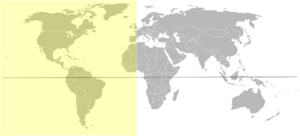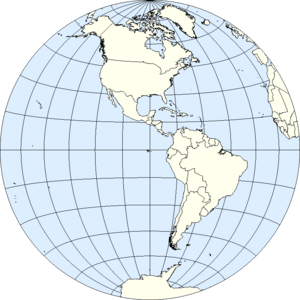Western hemisphere facts for kids
The western hemisphere is a way to talk about one half of our planet, Earth. Imagine drawing a line from the North Pole, through a place called Greenwich in England, all the way down to the South Pole. This line is called the Prime Meridian. The Western Hemisphere is everything to the west of this line. The other half of Earth is called the Eastern Hemisphere.
Contents
Where is the Western Hemisphere?
Most of the land in the Western Hemisphere is made up of the continents of North and South America. This means countries like the United States, Canada, Mexico, Brazil, and many others are all found here.
But it's not just the Americas! A small part of Africa (like Senegal and Mauritania) and parts of Europe (like Iceland and western Ireland) are also technically in the Western Hemisphere because they are west of the Prime Meridian. However, when people usually talk about the Western Hemisphere, they are often thinking about the Americas.
What is the Prime Meridian?
The Prime Meridian is an imaginary line that goes from the North Pole to the South Pole. It's used to help us figure out longitude, which is how far east or west a place is. It's like the starting point for measuring how far west or east you are on Earth.
Exploring the Western Hemisphere
The Western Hemisphere is home to many different climates and landscapes. You can find everything from the cold Arctic regions in the north to the warm tropical rainforests near the equator. There are also huge mountain ranges, vast deserts, and long coastlines.
This half of the world has a rich history, including ancient civilizations like the Maya and Inca, and the arrival of European explorers centuries ago. Today, it's a place of diverse cultures, languages, and traditions.
Related pages
See also
 In Spanish: Hemisferio occidental para niños
In Spanish: Hemisferio occidental para niños



